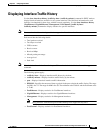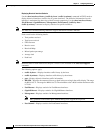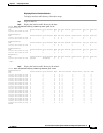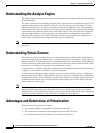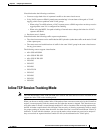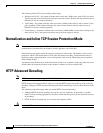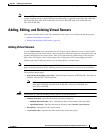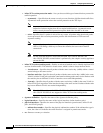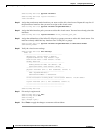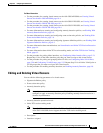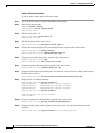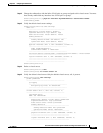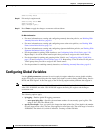
6-5
Cisco Intrusion Prevention System CLI Sensor Configuration Guide for IPS 7.1
OL-19892-01
Chapter 6 Configuring Virtual Sensors
Adding, Editing, and Deleting Virtual Sensors
Note Because HTTP advanced decoding requires the Regex card and the String XL engine, it is available only
to those platforms that have them. HTTP advanced decoding is supported on the IPS 4345, IPS 4360,
IPS 4510, IPS 4520, ASA 5585-X IPS SSP, ASA 5525-X IPS SSP, ASA 5545-X IPS SSP, and
ASA 5555-X IPS SSP.
Adding, Editing, and Deleting Virtual Sensors
This section describes how to add, edit, and delete virtual sensors, and contains the following topics:
• Adding Virtual Sensors, page 6-5
• Editing and Deleting Virtual Sensors, page 6-9
Adding Virtual Sensors
Use the virtual-sensor name command in service analysis engine submode to create a virtual sensor.
You can create up to four virtual sensors. You assign policies (anomaly detection, event action rules, and
signature definition) to the virtual sensor. Then you assign interfaces (promiscuous, inline interface
pairs, inline VLAN pairs, and VLAN groups) to the virtual sensor. You must configure the inline
interface pairs and VLAN pairs before you can assign them to a virtual sensor.
Note Anomaly detection is disabled by default in IPS 7.1(2)E4 and later. You must enable it to configure or
apply an anomaly detection policy. Enabling anomaly detection results in a decrease in performance.
The following options apply:
• http-advanced-decoding {true | false}—Enables deeper inspection of HTTP traffic. The default is
disabled. Valid for IPS 7.1(5)E4 and later.
Note HTTP advanced decoding is supported on the IPS 4345, IPS 4360, IPS 4510, IPS 4520,
ASA 5585-X IPS SSP, and ASA 5525-X IPS SSP, ASA 5545-X IPS SSP, and
ASA5555-XIPSSSP
Caution Enabling HTTP advanced decoding severely impacts system performance.
• anomaly-detection—Specifies the anomaly detection parameters:
–
anomaly-detection-name name—Specifies the name of the anomaly detection policy.
–
operational-mode—Specifies the anomaly detection mode (inactive, learn, detect).
• description—Description of the virtual sensor.
• event-action-rules—Specifies the name of the event action rules policy.



